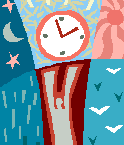 |
Student AreaCircadian Rhythms |
|
|
|
|
|
Each of us has an internal "body clock" in our brains. This part of our brain tells us when to feel wide awake and when to feel sleepy. Most of us have a similar pattern to our wakefulness and sleepiness, which varies over the course of every 24-hour period. Imagine that the figure below represents the face of a clock.
The green ("Go!") times are when we tend to feel awake and alert. Yellow ("Caution!") times are less alert. But the red ("Stop!") times are the very sleepiest of all. During these times, it may be very hard to stay awake, even when you are working or driving. People who must work or drive at those times should be very, very careful, because disastrous mistakes are much more likely. (Many countries have traditionally practiced widespread napping -- "siestas" -- in the afternoon.) The red/yellow/green times are generally the same, whether we are talking about a.m. or p.m. hours. But the sleepiness is much worse at night than in the afternoon. Of course, if you are sleep deprived, you are very sleepy all the time, even at times you would normally be alert. |
|
For more information on Circadian Rhythms, check out the Circadian Learning Center at Circadian Technology's web site.
|
